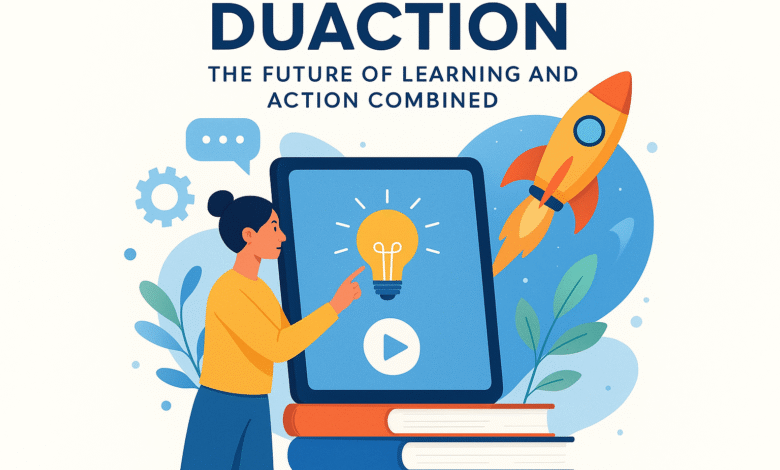Duaction: The Future of Learning and Action Combined

In the modern world, new terms and approaches continue to emerge that shape how we learn, work, and grow. One such innovative idea is duaction. Although still not widely known, duaction is quickly gaining recognition as a forward-thinking concept that connects education with practical application. Instead of separating theory from real-world practice, duaction blends them together into a single, powerful process that drives learning and success.
In this article, we will explore what duaction means, why it matters in today’s society, how it can be applied in different fields, and what the future may look like with duaction at the center of personal and professional growth.
What is Duaction?
Duaction is a term that brings together two powerful elements: education and action. The idea is simple but impactful—learning is only truly effective when it is directly paired with doing. In traditional systems, individuals often spend years studying theories and concepts before they have a chance to apply them. Duaction challenges this model by advocating for a system where knowledge and application happen side by side.
Think of duaction as a cycle: learn something, apply it immediately, reflect on the results, then improve. This cycle strengthens both understanding and performance, creating a deeper connection between theory and practice.
Why Duaction Matters in Today’s World
The world today is moving faster than ever before. Technology, business, education, and society are changing at a pace that demands adaptability. In this environment, duaction offers multiple advantages that make it essential:
-
Bridging the Gap Between Theory and Practice
Many people complete their education only to find they are unprepared for the real world. Duaction eliminates this problem by ensuring that knowledge is tested in real-life situations right from the start. -
Accelerated Skill Development
When individuals practice while they learn, they build skills much faster. Instead of waiting years to apply knowledge, duaction ensures that practical experience grows alongside academic understanding. -
Building Confidence
Taking action while learning builds confidence. Each time a learner applies a concept successfully, they reinforce their belief in their abilities. This confidence is crucial for personal growth and professional success. -
Encouraging Innovation
By testing knowledge in real-world situations, duaction encourages people to think creatively, solve problems, and find innovative solutions rather than just memorizing information. -
Relevance in the Digital Era
With industries changing rapidly due to artificial intelligence, automation, and new technologies, the ability to learn and apply quickly is more important than ever. Duaction makes individuals adaptable and future-ready.
Duaction in Education
One of the most important applications of duaction is in the education system. Traditional schools and universities often focus heavily on lectures, exams, and theoretical models. While these are valuable, they can leave students unprepared for actual challenges in the workplace or society.
By integrating duaction into education, schools can combine classroom learning with real-world projects, internships, and problem-solving activities. For example, instead of just studying entrepreneurship in theory, students could start small businesses or community projects while still learning in class. This approach not only improves understanding but also develops critical skills like teamwork, leadership, and adaptability.
Duaction in education ensures that students graduate not only with degrees but also with hands-on experience that makes them job-ready and capable of contributing to society from day one.
Duaction in the Workplace
Businesses are constantly searching for ways to improve employee performance, innovation, and adaptability. Duaction can play a transformative role in workplace training and development.
Rather than providing employees with long training sessions followed by delayed implementation, companies can apply duaction by mixing learning modules with immediate practice. For example, after learning a new digital tool, employees can apply it directly to an ongoing project. This ensures retention of knowledge and builds mastery faster.
Duaction in the workplace also creates a culture of continuous learning. Employees do not view training as something separate from work but as an ongoing process that blends seamlessly with their daily responsibilities. This results in a workforce that is skilled, confident, and constantly improving.
Duaction for Personal Development
On an individual level, duaction can be applied in almost every area of life. Whether learning a new language, mastering coding, or practicing public speaking, duaction ensures faster progress by pairing learning with action.
For example, someone learning a new language should not only study grammar and vocabulary but also practice speaking daily with native speakers or language partners. Similarly, someone learning to code should build real projects instead of just reading programming concepts.
This hands-on approach makes personal growth more engaging, effective, and rewarding. It also prevents the frustration many learners face when they spend months studying but feel unprepared when it comes time to perform.
Challenges of Implementing Duaction
While the benefits of duaction are clear, implementing it can face challenges:
-
Resistance to Change – Traditional systems are deeply rooted in separating theory and practice, making it difficult to shift mindsets.
-
Lack of Resources – Not all institutions or individuals have access to the resources needed for immediate application of knowledge.
-
Fear of Failure – Many learners hesitate to take action because they fear making mistakes, even though failure is part of the duaction process.
Overcoming these challenges requires open-mindedness, innovative approaches, and supportive environments that encourage experimentation and learning by doing.
The Future of Duaction
As industries, education systems, and individuals continue to adapt to rapid global changes, duaction is likely to play a central role in shaping the future of learning and work. Some possible developments include:
-
Integration into Curriculums – Schools and universities around the world may begin to formally include duaction as part of their teaching models.
-
Corporate Adoption – Businesses could design training programs entirely around the duaction philosophy, ensuring employees are always growing in both knowledge and practice.
-
Digital Platforms for Duaction – Online learning platforms may evolve to include immediate practical applications alongside lessons, providing learners with both theory and action in real-time.
-
Global Recognition – Just as terms like “blended learning” and “lifelong learning” became mainstream, duaction has the potential to become a recognized and widely adopted concept worldwide.
Read also: Who Delivers Your Offer to the Seller Framework: Everything You Need to Know
Conclusion
Duaction is more than just a new word—it is a revolutionary approach that combines education and action into one seamless process. By ensuring that knowledge is always paired with practice, duaction builds stronger skills, confidence, and adaptability. Whether in schools, workplaces, or personal development, duaction has the power to transform how we learn and grow in the modern era.
As the world continues to evolve, those who embrace duaction will be better prepared to face challenges, innovate, and succeed. The future belongs to learners who take action, and duaction is the key that unlocks that future.



